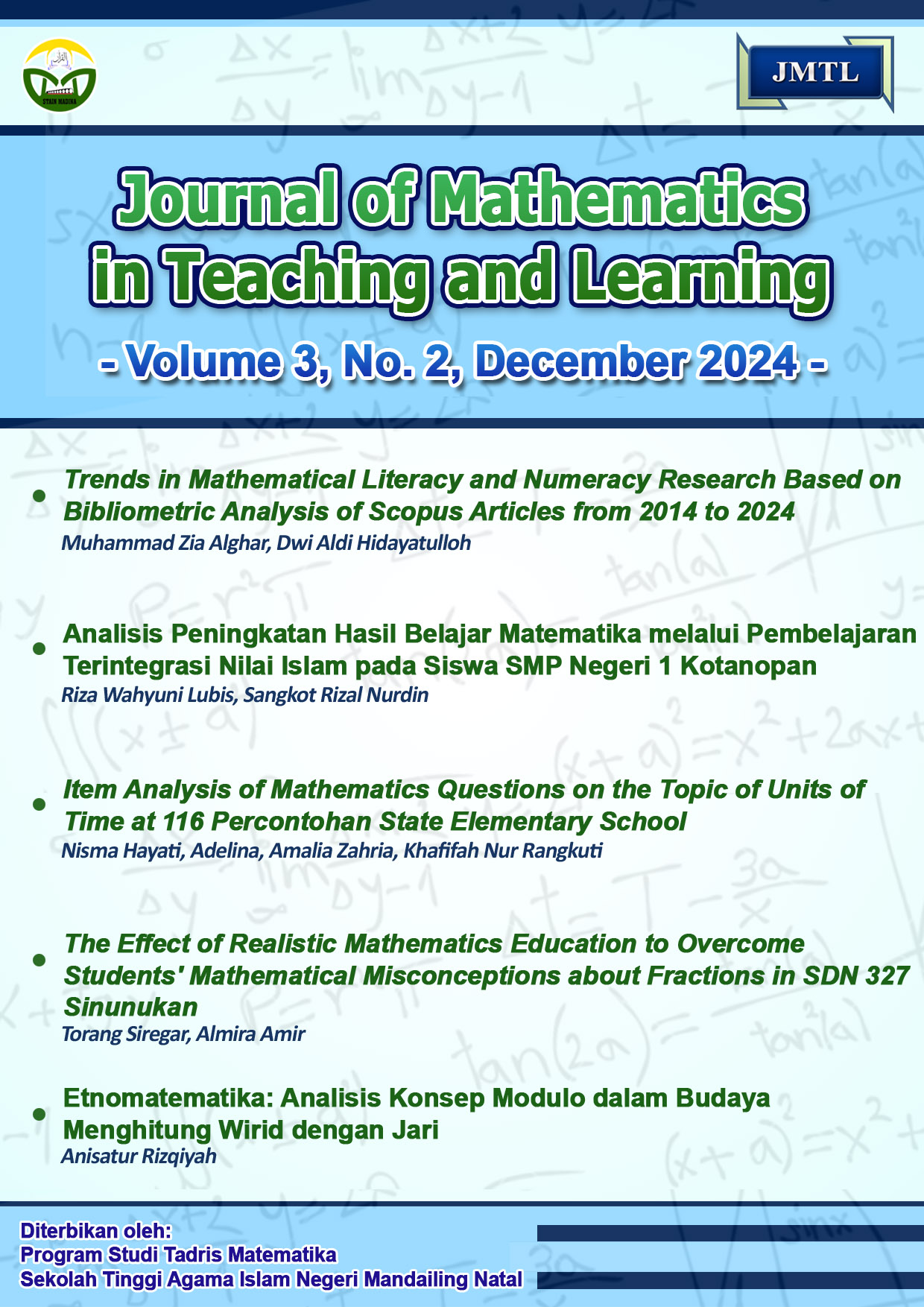Etnomatematika: Analisis Konsep Modulo dalam Budaya Menghitung Wirid dengan Jari
Keywords:
etnomatematika, wirid, jari, aritmetika moduloAbstract
Penelitian ini bertujuan untuk mengeksplorasi keterkaitan antara konsep kongruensi dan aritmetika modulo dengan tradisi budaya menghitung wirid menggunakan jari yang masih dilestarikan masyarakat muslim. Metode penelitian yang digunakan adalah deskriptif kualitatif melalui wawancara mendalam dengan tiga tokoh agama di Pasuruan dan Probolinggo. Hasil penelitian menunjukkan adanya tiga pola utama dalam praktik menghitung wirid dengan jari, yaitu: (1) setiap jari dihitung sebagai satu bilangan, (2) ruas jari digunakan sebagai satuan hitungan, dan (3) kombinasi ruas dan ujung jari untuk mencapai jumlah 33. Analisis matematis memperlihatkan bahwa praktik tersebut dapat dimodelkan dengan konsep kongruensi dan aritmetika modulo, misalnya 100 ? 1 (mod 33). Temuan ini mengungkap bahwa budaya menghitung wirid menggunakan jari tidak hanya sarat dengan nilai spiritual, tetapi juga menyimpan praktik matematis yang relevan sebagai sumber kontekstual dalam pembelajaran matematika.
References
Akbar, L. A., Alghar, M. Z., Marhayati, & Susanti, E. (2023). The Arithmetic Sequences in Making Traditional Cast Nets in Lombok. Edumatika: Jurnal Riset Pendidikan Matematika, 6(1), 13–29. https://doi.org/10.32939/ejrpm.v6i1.2541
Al-Kandahlawi, M. M. Z. (2011). Kitab Fadhilah Amal.
Alghar, M. Z., Malay, I., & Slawantya, Y. R. (2024). Asesmen pemecahan masalah bernuansa etnomatematika untuk mengukur kemampuan berpikir analitis siswa. Journal of Mathematics in Teaching and Learning, 3(1), 168–181.
Ami, R. (2021). Etnomatematika Pada Kebiasaan Orang Sunda Dalam Menentukan Tanggal Pernikahan Dan Kecocokan Pasangan Pengantin. Jurnal PEKA, 4(2). https://doi.org/10.37150/jp.v4i2.842
Aziz, M. S. N. B. A., Hishamudin, N. I. B. N., & Dahnil, D. P. (2023). A Modern Zikr Practice through the Portable Digital Tasbih Solution. 2023 IEEE International Conference on Computing (ICOCO), 334–338.
Barrocas, R., Roesch, S., Dresen, V., Moeller, K., & Pixner, S. (2020). Embodied numerical representations and their association with multi-digit arithmetic performance. Cognitive Processing, 21(1), 95–103. https://doi.org/10.1007/s10339-019-00940-z
Bender, A., & Beller, S. (2012). Nature and culture of finger counting: Diversity and representational effects of an embodied cognitive tool. Cognition, 124(2), 156–182. https://doi.org/10.1016/j.cognition.2012.05.005
Berteletti, I., & Booth, J. R. (2015). Perceiving fingers in single-digit arithmetic problems. Frontiers in Psychology, 6, 226. https://doi.org/10.3389/fpsyg.2015.00226
Burton, D. M. (2011). The History of Mathematics (7th Eds). MaGraw-Hill.
d’Ambrosio, U. (2001). In My Opinion: What Is Ethnomathematics, and How Can It Help Children in Schools? National Council of Teachers of Mathematics (NCTM), 7(6), 308–310. https://doi.org/10.5951/tcm.7.6.0308
D’Ambrosio, U. (1985). Ethnomathematics and its place in the history and pedagogy of mathematics. For the Learning of Mathematics, 5(1), 44–48.
Gerdes, P. (2001). Ethnomathematics as a new research field, illustrated by studies of mathematical ideas in African history. Science and Cultural Diversity: Filing a Gap in the History of Sciences. Cuadernos de Quipu, 5, 10–34.
Gerdes, P. (2017). Interweaving Geometry and Art: Examples from Africa. In K. Fenyvesi & T. Lähdesmäki (Eds.), Aesthetics of Interdisciplinarity: Art and Mathematics (pp. 181–195). Birkhäuser, Cham. https://doi.org/10.1007/978-3-319-57259-8_10
Hakim, L. (2008). Kualitas Hadis-Hadis Zikir. UIN Syarif Hidayatullah Jakarta.
Hamsyah, F., & Subandi. (2017). Dzikir and happiness: A mental health study on an Indonesian Muslim Sufi Group. Journal of Spirituality in Mental Health, 19(1), 80–94. https://doi.org/10.1080/19349637.2016.1193404
Hamzani, Y. (2020). Akulturasi Budaya Lokal Dan Agama Islam Dalam Menyambut Ramadhan: Studi Kasus Tradisi Mersik Di Kebon Daya, Masbagik Timur. Al-Irfani: Journal of Al Qur’anic and Tafsir, 1(1), 18–32.
Herstein, I. N. (1980). Multiplicative commutators in division rings II. Rendiconti Del Circolo Matematico Di Palermo, 29(3), 485–489. https://doi.org/10.1007/BF02849763
Klein, E., Moeller, K., Willmes, K., Nuerk, H.-C., & Domahs, F. (2011). The influence of implicit hand-based representations on mental arithmetic. Frontiers in Psychology, 2, 197. https://doi.org/10.3389/fpsyg.2011.00197
Kullberg, A., & Björklund, C. (2019). Preschoolers’ different ways of structuring part-part-whole relations with finger patterns when solving an arithmetic task. ZDM, 1–12.
Kullberg, A., Björklund, C., Brkovic, I., & Runesson Kempe, U. (2020). Effects of learning addition and subtraction in preschool by making the first ten numbers and their relations visible with finger patterns. Educational Studies in Mathematics, 103(2), 157–172. https://doi.org/10.1007/s10649-019-09927-1
Newman, S. D., & Soylu, F. (2014). The impact of finger counting habits on arithmetic in adults and children. Psychological Research, 78(4), 549–556. https://doi.org/10.1007/s00426-013-0505-9
Ramadhan, U. F. (2019). Dzikir Pagi & Petang. Fillah Books.
Rodrigues, J., Orey, D. C., & Rosa, M. (2021). The (re)discovery of mathematical knowledge outside of school from a math trail: a study based on Ethnomodelling. Revista Latinoamericana de Etnomatemática, 14(2), 74–75. http://funes.uniandes.edu.co/26025/
Rosa, M., Ambrósio, U., Orey, D. C., Shirley, L., Alangui, W. V, & ... (2016). Ethnomathematics and its diverse pedagogical approaches. repositorium.sdum.uminho.pt. https://repositorium.sdum.uminho.pt/handle/1822/51236
Rosa, M., & Orey, D. C. (2016). Ethnomodelling as a creative insubordination approach in mathematics education. In Journal of Mathematics and Culture (Vol. 10, Issue 3, pp. 111–134).
Seidenberg, A. (1962). The ritual origin of counting. Archive for History of Exact Sciences, 2(1), 1–40.
Suryadilaga, M. A. (2016). Zikir Memakai Biji Tasbih dalam Perspektif Living Hadis. Dialog, 39(1), 89–106. https://doi.org/10.47655/dialog.v39i1.24
Umbara, U., Wahyudin, W., & Prabawanto, S. (2021). Exploring ethnomathematics with ethnomodeling methodological approach: How does cigugur indigenous people using calculations to determine good day to build houses. Eurasia Journal of Mathematics, Science and Technology Education, 17(2), 1–19. https://doi.org/10.29333/ejmste/9673
Valdivia, M. E. C.-R. De, Pascualvaca, P. M., & Albanese, V. (2022). Local practices and mathematical contextualized tasks from Andalucia, Spain. Revista Latinoamericana de Etnomatemática, 15(1), 41–63. https://revista.etnomatematica.org/index.php/RevLatEm/article/view/666
Weil, A. (2012). Number theory for beginners. Springer Science & Business Media.
Yulianto, E., Mansyur, M. Z., Jayusman, I., & Miftahudin, Z. (2022). The Way Sundanese Give Names Totheir Baby: Cultural Anthropology View In ethnomathematical Studies. Journal of Authentic Research on Mathematics Education, 4(2), 263–280. https://doi.org/https://doi.org/10.37058/jarme.v4i2.3161
Yulianto, E., Wahyudin, W., Tafsir, A., & Prabawanto, S. (2021). Contrasting mathematical phenomena and concepts in ethnomathematics through etic and emic approaches: A study of dhikr jahar practices in tariqa qodiriyah naqsyabandiyah ma’had Suryalaya. Al-Jabar: Jurnal Pendidikan Matematika, 12(1), 193–218. https://doi.org/10.24042/ajpm.v12i1.8805
????, ?. ?., & ???????. (1111). ????? ???????. ???? ?? ???? ?? ???? ???????.
Downloads
Published
How to Cite
Issue
Section
License
Copyright (c) 2024 Anisatur Rizqiyah

This work is licensed under a Creative Commons Attribution-NonCommercial-ShareAlike 4.0 International License.







